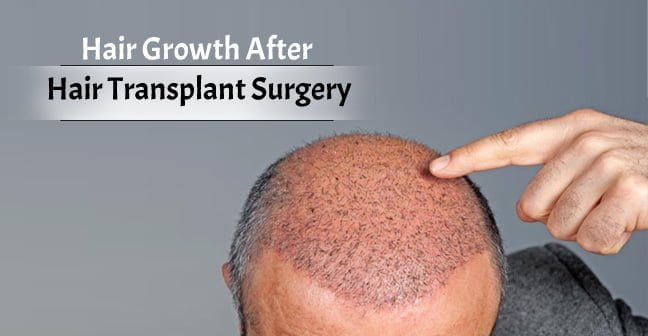Wondering How fine will be the Hair Growth after Hair Transplant? We all agree that the hardest part of a hair transplant in jaipur comes after the procedure is done. We constantly look in the mirror trying to find the results or changes and it sometimes this affect us deeply. Hair Transplantation, whether performed by Follicular Unit Transplantation (FUT (strip procedure)) or Follicular Unit Extraction (FUE), is a highly successful operation in the vast majority of patients (generally > 90%). The catch, of course, is that you must wait many MONTHS for the final result.
Also Read: Why FUE Hair Transplantation is Remarkable than FUT
Usually, there is Normal hair growth cycle after the hair transplant, each hair follicle has its own cycle. Depending on its position in its cycle, once implanted it will go through its cycle and therefore grows in accordingly. So normally gradually hair starts to grow in. Although it’s difficult to predict the growth pattern of hair after hair transplant surgery for every individual, a sum up timeline is provided here for the patient to understand and have an idea about what would happen and when it would happen
Also Read: Things to consider while selecting a Hair Transplant Centre
The cycle of Hair Growth after Hair Transplant Surgery
- Day 0– the day of the surgery is counted as day 0.
- Day 1-5: The first 2 weeks after the hair transplant is the most critical. During the first 5 days, patients may experience swelling of the forehead and at the back of the head, which is the donor area. The skin may also look red at the areas where all the tiny incisions were made for the newly transplanted hairs. This redness usually resolves after the first week or 2. After only a few days, the donor area is no longer tender.
- Days 6 – 10: At this point, patients no longer experience any swelling and the redness should only be faint or completely gone. For each follicular unit transplanted, a “crust” will form which is the attached skin layer drying out. This scab can be gently removed by soaking and gentle rubbing with fingers. By day 10, all the crusting should be gone and the transplanted hairs will appear like a “crew-cut” haircut.
- Week 2- 3: The transplanted hairs will start to shed at this point, and by the end of the 3rd/4th week, most will be gone. This is a normal part of the healing process and is totally expected. The newly transplanted hairs go through a shedding process as the actual hair shaft is released, but the actual follicular unit and bulb are totally intact starting to grow a new hair shaft. patients may feel like the operation was a failure but this is part of the normal hair cycle.
- End of Month 1 – Month 2: The hair follicles have entered into the resting phase of their cycle. The length of the resting phase can vary before they start to grow again. At this stage, patients will appear exactly as they did prior to surgery with regards to the amount of hair present.
- Months 2 – 4: The new hairs should start coming out. For some patients, their transplanted hairs start growing early in the timeline; for others, they start growing later. Patients will see the new transplants, but they will be thin at this stage as they begin to emerge from the scalp. Most of the native hair will be growing back at this time. The donor area is healing and any redness at the donor site will resolve.

- Month 6: Transplanted hair has entered the anagen phase and begins to grow (finally…progress!). At this point usually, the doctor used to see you in follow up.
- Months 6 – 9: Patients will start to see a considerable amount of hair emerging from the scalp. The hairs are thinner; many of the transplanted hairs will be over 3 inches or longer and is able to be groomed. Toward the end of this period, the hair will show textural changes and start to thicken up. The donor area will be completely healed at this point. The original donor laxity is restored by month 9.
- 1 Year: Patients have achieved about 80% of the hair growth of the transplanted hairs. Most of the hairs will have emerged from the scalp. At this point, further density is unlikely to noticeably improve without further surgical and/or nonsurgical intervention (PRP). It’s time to focus on outcome maintenance!
- After 1 year: For some patients, they achieve the full appearance by 1 year; others will take longer for the hairs to emerge and increase their density and thickness. Additionally, as the hair grows longer, that provides a fuller appearance since the volume of hair is increased at the transplanted area
The natural hair growth cycle after hair Transplant takes time and is generally imperceptible because at any given time 5-10% is falling out under a roughly EVEN DISTRIBUTION. When you have a hair transplant, in the course of 1 day, all the transplanted hair suddenly enters the same growth cycle!
Also Read: Is Hair Transplant A Permanent Solution
A healthy approach to any surgical procedure is a solid grasp of the standard postoperative course. In general, try to be patient for about a year to see how things are going before you give up. You should always talk with your surgeon to get his/her opinion and elicit communication.
You May Also Like to Read: 12 Common Myths and Facts About Hair Transplantation
Dr. Sachin Sharda is a good choice for any hair-related treatment. He is a highly skilled Dermatologist in Jaipur who offers the best hair-related treatments, and provide best low-level laser therapy, laser hair removal, and hair transplant cost in Jaipur.



